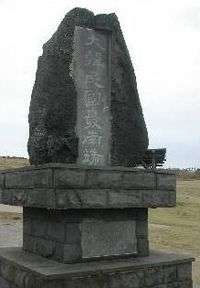Marado
Coordinates: 33°07′N 126°16′E / 33.117°N 126.267°E
| Marado | |
 | |
| Korean name | |
|---|---|
| Hangul | 마라도 |
| Hanja | 馬羅島 |
| Revised Romanization | Marado |
| McCune–Reischauer | Marado |

Marado or Mara Island is an island 8 km off the south coast of Jeju, in southernmost South Korea,[1][2] having an area of 0.3 km². It is home to about 90 people, and has long been known for its population being composed of strong women and docile men.[3] It's becoming a popular tourist destination, thanks to the many unusual rock formations, and is connected to the mainland by two regular ferries and numerous excursion boats.
Mara-do is within the administrative boundaries of Daejeong Township (Daejeong-eup) in Seogwipo City, and is included, along with Gapa Island (Gapado), in Gapa-ri, and is South Korea's southernmost point.
Because of its subtropical marine habitat the island is a natural reserve. It was designated as National Monument no. 423 (천연기념물 제423호) on July 18, 2000.
Overview
Marado was originally uninhabited. It was known as Keumdo (금도,禁島), which means forbidden island. According to a Choson Ilbo article published by Lee Kyu-tae in 1967, the island was first occupied by a woman named Kim Seong-oh (김성오,金成五) and her brothers in 1880. As a poor peasant with no land to farm, Kim Seong-oh decided to move to the island when her father mentioned the island on his deathbed. So Kim left Jeju with her two brothers, farming tools, and some seeds. They had to circle the island around three times, because they couldn't find a place to dock their boat. After about 10 years, they were joined by two stranded fishermen from Torishima (도리섬,鳥島), in the Kingdom of Ryukyu.[4]
However, documents from Jeju county also had another story on Marado. According to this story, the first residents came to live on Marado in 1883. One Mr. Kim originally living in Daejeong gol, a small village in Jeju, ran through his all fortune. His relatives proposed to let them move to Marado. Sim Hyun Taek, pastor of Jeju at that time, permitted them to do so, and Marado became inhabited for the first time. After independence, it was administered by Gapa-ri, Daejeong-eup of Jeju, and registered as an independent township(ri) called Marari.
Coastline
Marado is an island with an exceptionally rocky coastline; sea caves are found on the island as well. The overall length of the island's coastline is 4.2 km.[5] There is a walking track around the island offering a scenic view of the coast. Walking on foot around the island takes about one hour.
Due to tidal erosion, the east coast consists of extremely steep cliffs called Gue Jeong by residents. Their altitude extends to 39m and plants such as Korean cacti and ditch deeds are found here.
There are 4 docks on Marado, called Sal-rae duck, Jariduck, Jangsiduck and Sinjak-no, respectively. Fishery resources are largely abundant throughout the year, especially in Jariduck.[6]
Present
There is an elementary school, police station, church, a temple and lighthouse on Marado. Forty households are registered here and about 700 tourists a day come to visit. For them, fifty accommodations have been provided.
Environment
Marado's coastal features and basalt rocks are the best for many fish, ear shells, turban shells and seaweeds. There used to be no trees on the island, but a small forest was planted in the middle of the island. It is protected by a fence.
Tourist Spots
Solar-power Plants
There are solar-power plants located on the northern coast of Marado, a scarce sight in South Korea. Combined capacity is about 30 kW; the plants provide 27 households with electricity.[7]
Chocolate Museum
This small museum is one of the main landmarks in Marado, built in a Renaissance style.
Cheonyeodang Temple
Cheonyeodang is a sightworthy small temple in the only village on Marado. In this temple, people pray for the divers' safety.[5]
Janggun Rock
Janggun Rock means "General's Rock". Traditionally, the island's inhabitants consider this rock as a guardian. It is quite common for shore-dwellers to believe in nature and natural phenomena, and Janggun rock is sacred for Marado's residents.[8]
 Village on Marado
Village on Marado Forest in the middle of Marado
Forest in the middle of Marado Main Street of the village
Main Street of the village Rock indicating the southernmost point of Korea
Rock indicating the southernmost point of Korea Coast
Coast Church near the forest
Church near the forest Temple
Temple
References
- ↑ "Introduction to Administrative Units". Korea Land Portal. Retrieved 2007-03-18.
- ↑ 韩国 (in Chinese). Yunnan e-government. 2005-04-26.
- ↑ Onishi, Norimitsu (July 17, 2006). "A Tourist Boat Nudges Women Out of the Driver's Seat". New York Times. Retrieved May 12, 2010.
- ↑ http://kr.blog.yahoo.com/waterview33/969
- 1 2 Jeju-do Tourist Association: Jeju, Korea - an invitation to the paradise, p. 46. Jeju 2004
- ↑ 대한민국 최남단 마라도 관광 | 유양해상 관광주식회사〃 Yuyang Marin Resort
- ↑ 대한민국 최남단 마라도 관광 | 유양해상 관광주식회사〃 Yuyang Marin Resort
- ↑ 대한민국 최남단 마라도 관광 | 유양해상 관광주식회사〃 Yuyang Marin Resort
See also
- Islands of South Korea
- List of Korea-related topics
- Birds of Marado Island
- ROKS Marado, a planned Dokdo-class amphibious assault ship.